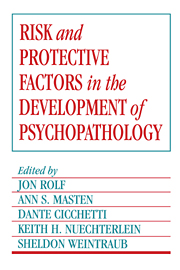Book contents
- Frontmatter
- Contents
- List of contributors
- Preface
- Part I Introduction: Historical and theoretical roots of developmental psychopathology
- Part II Contributions of the high-risk child paradigm: continuities and changes in adaptation during development
- 3 Early contributors to developmental risk
- 4 Beyond diathesis: toward an understanding of high-risk environments
- 5 Hard growing: children who survive
- 6 Children born at medical risk: factors affecting vulnerability and resilience
- 7 A mediational model for boys' depressed mood
- 8 A temperamental disposition to the state of uncertainty
- Part III Competence under adversity: individual and family differences in resilience
- Part IV The challenge of adolescence for developmental psychopathology
- Part V Factors in the development of schizophrenia and other severe psychopathology in late adolescence and adulthood
- A closing note: Reflections on the future
- Author index
- Subject index
5 - Hard growing: children who survive
Published online by Cambridge University Press: 06 August 2010
- Frontmatter
- Contents
- List of contributors
- Preface
- Part I Introduction: Historical and theoretical roots of developmental psychopathology
- Part II Contributions of the high-risk child paradigm: continuities and changes in adaptation during development
- 3 Early contributors to developmental risk
- 4 Beyond diathesis: toward an understanding of high-risk environments
- 5 Hard growing: children who survive
- 6 Children born at medical risk: factors affecting vulnerability and resilience
- 7 A mediational model for boys' depressed mood
- 8 A temperamental disposition to the state of uncertainty
- Part III Competence under adversity: individual and family differences in resilience
- Part IV The challenge of adolescence for developmental psychopathology
- Part V Factors in the development of schizophrenia and other severe psychopathology in late adolescence and adulthood
- A closing note: Reflections on the future
- Author index
- Subject index
Summary
Children are inherently vulnerable, but also they are strong in a determination to survive and grow. Over the generations of scientific study, these complementary themes have directed much research concerned with children's physical and psychological development under conditions that threaten their well-being or survival. The field of study known as “risk research” provides an example of this dual orientation, with its focus on the individual's vulnerabilities and resistances to risk and stress (Garmezy, 1981).
One historical stimulus for the present era of risk studies is no doubt to be found in the observations by Spitz and Wolf (1946) of infants’ responses to institutionalization and lack of mothering. Severe disturbances, described as anaclitic depression, developed in some infants, and some of these infants died. A little more than a decade later, Harry Harlow gave his American Psychological Association presidential address on “The Nature of Love” (1958). His findings, based on an animal model and an experimental paradigm, showed similar stark results with infant monkeys: Severe environmental deprivation has profound effects on infants’ social, emotional, cognitive, and physical development and well-being. The multitude of studies that followed almost all documented or elaborated the findings of deteriorative processes set in motion when infant monkeys were deprived of mothering. Across a wide range of studies on human infants who had suffered deprivations and neglect, as reviewed by Yarrow (1961), there were similar conclusions concerning both immediate and enduring damage to children. In the voice of that period, the primary message was that biological sufficiency was not sufficient, that monkey and human infants alike depended on love and psychological nurturance for their survival.
- Type
- Chapter
- Information
- Publisher: Cambridge University PressPrint publication year: 1990
- 65
- Cited by

